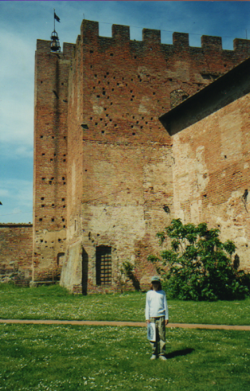Ladies bicycle in fur coats and high heels in Ferrara, Italy. They carry umbrellas and smoke cigarettes as they bike, too, as if they had three hands. It’s amazing to see them winding their ways down the medieval, cobblestone streets, as if balance and gravity and even time operate on different laws of physics there.
My family lived in Ferrara a few years back, and I bought an old, beat-up red bike of my own. In time, I could bicycle with bags of groceries hanging from my handlebars just like the Ferrarans. You just have to start up slow, not sway too much, and watch it on the turns.
There were other charms to the city, too. I walked my three children to school every morning, often in fog so dense that the great obelisk of Piazza Ariostea would materialize only suddenly and very near. We visited the Castello Estense so frequently that we knew its dungeons, towers, moat and orange terrace by heart.
When I started imagining the setting for my upcoming novel, Birthmarked, I didn’t consciously think of the walled city of Ferrara. At the time, I was walking regularly in the hills of Tiburon, overlooking San Francisco Bay with its own version of fog. The hillsides mounded treeless and arid; the California poppies bloomed their impossible orange. Hungrily soaking in the views, I began to picture a similar landscape, but even more dry. I’d been to Lake Superior as a girl and I’d studied in Death Valley, and those places mattered, too.
Then, as the story progressed, and I juxtaposed a future, technologically superior society with a community living in primitive, medieval conditions, I needed a wall to divide them.
My Enclave needed a monument and narrow streets and cobblestones. I needed towers and a prison. Seminal knowledge of Ferrara and other walled cities like Lucca and Certaldo hovered, ready to be plumbed. At least, I believe that must be what happened on some deep level, but actually I’m finding these connections only in retrospect
It’s funny, isn’t it, to think where settings come from? >It makes sense that since I’ve climbed walls, big medieval ones, I can see the great one in my novel quite clearly. Yet, though it may seem like I’m contradicting myself, I’m not aware of consciously lifting a place from my memory when I’m writing a first draft. I’m not reliving a memory.
Instead, the settings I see in my novels become incredibly real to me, more real, even, than memories, because the fictional versions are completely alive to me while I’m in them. They are present. They’re so vivid they make my living room disappear. Even as my eyes are on the computer screen, I’m not really seeing the letters I type; I’m seeing and smelling and hearing the place in my book. I’m crawling under my wall, through a space no larger than the underside of a kitchen stool. I’m smelling the stone and damp earth there, at night time.
I like to play a mind game with my students, and once I tried it with parents on Open House night. I ask them to picture a beach in the summer, with the hot sand and the bright sky and the sounds of sea gulls and rushing waves. There’s a crowd of vacationers, with green-striped sun umbrellas and cigarette butts underfoot. Smell the suntan lotion, and see the girl in the pink suit crouching at the water’s edge with wet brown sand sticking to her fingers. Then, make it the same beach at night time. Most of the crowd is gone, but a few people have gathered around a bonfire, where light flickers on their faces. You can still hear the waves, but now the smell of water mixes with wood smoke. Next, take that night beach and make it wintertime. It’s really cold. The people are long gone, and you’re alone in your coat, with your nose exposed to the salty air. There’s moonlight, just enough so you can make out the foam edge of the waves where they touch the dark sand shore, and you can see when the sky starts to snow.
It works a little like that.
Oddly enough, it isn’t possible to have moonlight when it’s snowing. Not in real life. But once you start to trick all five of your senses at the same time in your mind, you can be places that have never existed. It’s a dangerous and addicting habit.
It’s even more magical and liberating than riding a bicycle.
Caragh O’Brien’s futuristic, dystopian story, Birthmarked, is due out from Roaring Brook Press in April, 2010. It is her first young adult novel.










